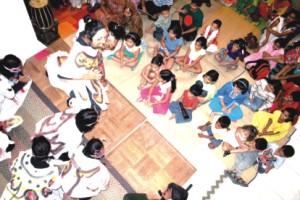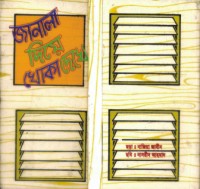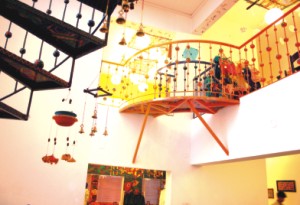| Cover Story
Reviving the Colours of Culture
Srabonti Narmeen Ali and Elita Karim
 The air in Jatra was filled with energy on May 14, as members of the band Bangla and their friends performed for their excited fans. Members of the audience joined in, singing the songs with such enthusiasm that the singers on stage could barely be heard over the clapping and cheering. The 'jam session' marked the end of a week-long festival at the store, in which music and theatre lovers took a journey into the realms of Bangladeshi culture, incorporating 'baul' music, traditional dances, drama, puppet shows and finally, an informal performance by various contemporary musicians of Dhaka. The festival took place from May 7-14, from 5-7 PM. The air in Jatra was filled with energy on May 14, as members of the band Bangla and their friends performed for their excited fans. Members of the audience joined in, singing the songs with such enthusiasm that the singers on stage could barely be heard over the clapping and cheering. The 'jam session' marked the end of a week-long festival at the store, in which music and theatre lovers took a journey into the realms of Bangladeshi culture, incorporating 'baul' music, traditional dances, drama, puppet shows and finally, an informal performance by various contemporary musicians of Dhaka. The festival took place from May 7-14, from 5-7 PM.
"Frankly speaking, I don't get to listen to folk music as much as I would like to,” says Fariha Nipu, a sophomore from North South University. “After a day's worth of work, my entertainment options are limited to the television or the music that I download from the internet. This has been a great opportunity for me to actually discover the many elements that give shape to the culture of Bangladesh and thoroughly enjoy them as well.”
The festival had performances that captivated people of all age groups. Each day of the festival started with the lighting of the diya by a member of the staff and would end with everyone moving upstairs to the roof for a cup of coffee and shingara at the makeshift cafeteria, especially constructed for the Jatra Festival.

Mustafa Monowar launches the children's book 'Janala Diye Khoka Dekhe' with author Nazia Jabeen, illustrator Nasreen Ahmad and book designer Anusheh Anadil
On the first day of the festival, Fakirs hailing from Kushtia filled the atmosphere with their powerful lyrics and enchanting voices. They used simple instruments like the dhol, dotara and flute which added to the stories they told through their song -- they spoke of the lives they lead, entwined with hints of forbidden love, suffering and an eagerness to explore the world around them. A lot of their expressions dealt with symbolism in daily life, a common feature in Lalon Shah compositions. For instance, Rob Fakir in one of the songs, spoke about how even the beauty of earth and its wonders could not reduce the pain of not seeing one's beloved. However, being with the beloved would not quench one's curiosity of travelling down below into the sea and discover God's creations.
Maya Rani and her troupe performed Pala Gaan on the second day of the Festival. Pala Gaan is a musical dialogue where 'discussions' take place. These discussions usually centre around reality, dreams and faith. Maya Rani's troupe discussed their thoughts on the roles of men and women, as well as religion and spiritualism.
 On the last day of the festival, various musicians including Bangla's bassist Buno performed for the audience |
“Allah demands certain duties from man,” says Abdul Alauddin, one of the musicians in the troupe. “The Rasul asked us to be kind to living beings, to act in such a way during our lifetime so that the Almighty will be satisfied. If we don't pray, don't love our fellow beings and resort to violence to get out own way, how can we face God and the Rasul in the after life?”
“We go on with our Pala Gaan performances for hours together, sometimes going through sleepless nights as well,” says Maya Rani, explaining the excitement which often grows with every passing moment amongst the audience and the musicians alike. Something that did not go unnoticed was the way each baul would introduce themselves and start a composition; warmly greeting everyone around and thanking them for staying and listening to the compositions.
On May 9, two famous contemporary musicians, Shayan and Moon enthralled the audience with their performances. Moon sang a few songs from his recently released album, Paper of Ektaar Productions. Shayan sang some of her favourites from Kalim Sharafi and Shahnaz Rahmatullah. Her own compositions sparked a lot of interest because of her spontaneous and often, political lyrics.
“I think what Anusheh and her team is doing with the Jatra Festival is fantastic,” she says. “I am planning to come and enjoy myself on the other days as well. This is just a mere start, and I hope that Jatra will so something similar once again in the near future.”
May 10 held a treat for children with Prachchonaat, the famous theatre group, which
 Theatre group Prachchonaat performs a comedy about ghosts for the young Jatra audience Theatre group Prachchonaat performs a comedy about ghosts for the young Jatra audience |
performed 'Bhuto-bhutomg' and 'Kupokat'. In 'Bhuto-bhutomg', the performers with their improvisation and voice modulation techniques had the children laughing at the young ghost who suffered from the 'Casper, the friendly ghost' syndrome -- he simply could not scare people. Their play, 'Kupokat' was about a jungle meeting, where the rabbit was asked to sacrifice itself to the ever-hungry tiger, for the sake of the honour and dignity of the other animals living in the forest. The children loved the costumes, which successfully completed the look of the jungle set-up, starting from a batting-eyed peacock to a rabbit with no tail. The play was accompanied by live music by Rahul Ananda and his team of theatre musicians. Prachchonaat, although a theatre group that usually does adult drama, hopes to perform more plays for children in the future. “We have a policy about children,” says Rahul. “'It ends with, 'let the children grow up through the colours of dance, rhythm and fun.'”
On May 11, Bhabna presented traditional dance forms and the famous story of Rana, a common man in Bangladesh, which symbolised the many hardships that are suffered by the poor people of the country. The audience easily related to the dramatised version of Rana, the labourer working from the crack of dawn till the sun sets, finally going home carrying his stick, a sack of bare essentials and a lantern. They also performed additional heart-warming compositions, encouraging the spirit of nationalism to grown within everyone present.
The last day of the festival was marked with Jatra's launching of 'Janala Diye Khoka Dekhe', a children's book by Nazia Jabeen. This colourful compilation of children's poetry was officially launched by the famous puppeteer Musafa Monowar, where the art work was done by Nasreen Ahmad and the design by singer and Proprietor of Jatra, Anusheh Anadil.
 “The books are hand made, starting from the wooden covers to the hand prints made inside,” says Nazia. “It became a little too expensive and not many customers might think of buying them. That is why we have thought of releasing these books in offset paper later on, keeping the original wooden covers intact.” “The books are hand made, starting from the wooden covers to the hand prints made inside,” says Nazia. “It became a little too expensive and not many customers might think of buying them. That is why we have thought of releasing these books in offset paper later on, keeping the original wooden covers intact.”
The book is about Khoka, a little boy who discovers the world in nature itself. “We are planning to do a series of books with Khoka,” says Nazia. “The next series will talk about Khoka's first experience on a train.” Aimed at children between 2-5 years of age, this book was the first book launch by Jatra.
The launch was followed by puppet shows by Mustafa Monowar. His puppets brought to life the stories from the Liberation War. “This is just another way to let our children know about the war and the martyrs involved,” says Monowar. “I have been doing the same puppet shows for years now. But I always keep in mind to check the changes that are occurring around me. For instance, the theme and storyline that I used in my puppet shows today are the ones that I had done years ago. But I still bring about a difference even decades later because of the new ideas and techniques that I use along with the changing time.”
A jam session signified the end of the Jatra Festival, in which musicians such as Buno, Shahed, Ornob, Labeek, Punam and many more brought the stage to life with their music. There were enticing musical improvisations on Andrew Morris' saxophone and Taher's flute, not to mention the superb vocal works rendered by Shanjib and dhol played by Nazrul. It was an open platform and anyone could come with an instrument and perform.
In addition to the festival, Jatra treated its customers to a 30% discount off of all their products, in celebration of “a new era” for the store, in which there will be more fun, more adda and more cultural events such as last week's festival.

Singer and Jatra Proprietor Anusheh Anadil says she plans on giving Jatra a brand new look in the near future
“When we first started the store we all had so much fun,” says Anusheh. “It was not just a job for anyone, it was all very spontaneous and relaxed. We wanted to have this festival celebrating Bangladeshi culture in order to bring that feeling back, so that people know that Jatra is not just another store where people buy things, but a place where everyone can have fun and hang out. We launched the store in a similar way, with an exhibition and a festival where different people performed. Throughout the years, however, that initial excitement has kind of died out and we wanted to bring it back.”
Jatra made its debut into Dhaka's retail market seven years ago, in late 2000, with its outfits, lamps, jewellery and its signature theme of painted colourful animals on handicrafts and home furniture. The space was originally an office space which Anusheh's father rented out. She had borrowed the space for an exhibition, in which she and her friends showcased many different products.
 “People were here by the dozen for the exhibition and we started doing really well,” says Anusheh. “So we ended up taking over the space and keeping it for the store.” “People were here by the dozen for the exhibition and we started doing really well,” says Anusheh. “So we ended up taking over the space and keeping it for the store.”
The name Jatra, contrary to popular belief, is not derived from the word for rural drama. Rather it is taken from the word that means journey.
“When one takes a journey through our country, there are so many bright colours all over the place,” says Anusheh. “For some reason, that particular aspect is missing in our handicrafts -- they are all very beautiful but they lack that brightness and that use of various colours. We wanted to bring that characteristic into the handicrafts of Bangladesh.”
Located on Kemal Attaturk Avenue in Banani, Jatra is unique because it incorporates traditional and folk styles with western styles of dress. Moreover, the majority of clothes made in Jatra are made with a traditional cloth called taant, (a handloom fabric) which is indigenous to Bangladesh. This fabric's texture is ideal for Bangladeshi weather as it breathes and is comfortable to wear.
“It's important to me that we use this fabric because it increases employment in Bangladesh,” says Anusheh. “The making of this fabric involves about ten people rather than cotton which does not need as many people. There are so many people who don't have jobs so if we can at least open up a market for this we will be able to provide them with employment in some way or another. It is also a really nice material, it's very comfortable.”

The Jatra Festival included a puppet show by Mustafa Monowar and Pala Gaan renditions by Maya Rani andher troupe
Aside from using traditional materials and fabrics, Jatra has also been successful in fusing Bangladeshi traditional wear and western outfits. It has provided Bangladesh's youth with an alternative style. Instead of taking fashion tips from India and the west, Bangali youngsters can now proudly sport a style that they can call their own. For example, the fotua, (a small sized panjabi to be worn with jeans or pants and occasionally a dupatta) has become a hot commodity all over Bangladesh with both men and women, thanks to trend-setting stores such as Jatra, Deshal and Prabartana.
 The fotua is one of Jatra's many innovative answers to fusion fashion |
“Fotuas are kind of something that we always wore when we were younger,” says Anusheh. “I used to borrow my Nana's short panjabis and wear them with pants. It is important for us to have our own identity, and our own style, rather than copying Indian fashion. Before there were two extremes -- you would either have the men and women wearing completely western outfits, (in the case of girls, tight jeans and t-shirts), or totally eastern clothes i.e. saris and shalwar kameezes. What Jatra has done is successfully created a bridge for these two extremes, which is what best describes our generation.”
Being a member of the popular band Bangla, which is known for “bringing folk music into the commercial helm for the youth,” Anusheh has also noticed the same trend in the Bangali youth with regards to their musical tastes.
“There was either the type of person who listened to hard core heavy metal or western music, or there was the type who listened to Rabindra Sangeet or Indian classical music,” she says. “I think that our generation today lives in an environment where they are exposed to the best of both worlds. There is no reason we can't be both. That is what we are trying to do with both our music and also with the store. Jatra aims to be a Bangladeshi trend-setting store.”
However, like anything else that is trend-setting and fashionable, Jatra has to change with the times. Which is why in July, Jatra will be celebrating the launch of a new look. Anusheh, along with her six designers, Shukla, Lubna, Reza, Babu, Liton and Azad have been working
 A Jatra employee lights the diya in order to symbolise the beginning of the festival A Jatra employee lights the diya in order to symbolise the beginning of the festival |
hard to revamp Jatra. Shukla, Babu and Lubna collectively work on home products, clothes and jewellery, while Azad works on paper products and jewellery. Liton specialises in rickshaw painting and also is a designer and finally Reza whose recent project 'Tokano Rong' (Rag Picked Colours) -- which involved creating a collage of artwork made from waste and then applying this artwork onto various household items such as cushion covers, tissue box covers, bags and wall hangings -- was  exported, along with various other handicrafts to Belgium. exported, along with various other handicrafts to Belgium. “I guess I see Jatra as my baby and since I have grown in so many ways as a person, I feel that Jatra has to grow as well,” says Anusheh. “I was not able to give Jatra my full attention before because I have had two kids since we started the store.”
She has two children, a boy, Arash Alem Ahmad and girl, Raha Alaleh, with husband and fellow band member Faizan Rashid Ahmad (Buno).
Although she was not as involved as she would have liked to be in the last few years, Anusheh is now hoping to promote a new and improved Jatra for her customers. She is planning on opening a second branch in Dhanmondi, which she hopes will provide a more interactive and relaxed atmosphere where people can come and enjoy themselves as well as buy the products.
“That is how Jatra originally started out,” says Anusheh. “It was like this hang out spot where people would come and enjoy themselves. I guess it is important for me to revive that feeling.”
Apart from reviving the feeling of camaraderie and excitement, Jatra has provided the youngsters of Bangladesh with an environment in which, not only can they learn more about the culture about their own country, but also take pride in fashion that is not borrowed from other cultures, but something that they can call their own.
Copyright
(R) thedailystar.net 2007 |
